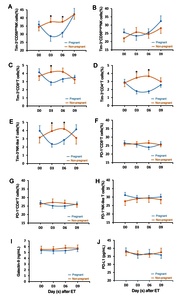ZHANG, Tao, ZHU, Wenyue, ZHAO, Yiwei, CHEUNG, Wing Ching, LIU, Yingyu, CHEN, Xiaoyan, DU, Yan, LEUNG, Kam Tong, CHAN, Yiu Leung, WANG, Chi Chiu, LAIRD, Susan and LI, Tin Chiu (2020). Early transient suppression of immune checkpoint proteins T-cell immunoglobulin mucin-3 and programmed cell death-1 in peripheral blood lymphocytes after blastocyst transfer is associated with successful implantation. Fertility and Sterility, 114 (2), 426-435. [Article]
Documents
26006:549608
PDF
Laird-EarlyTransientSuppression(AM).pdf - Accepted Version
Available under License Creative Commons Attribution Non-commercial No Derivatives.
Laird-EarlyTransientSuppression(AM).pdf - Accepted Version
Available under License Creative Commons Attribution Non-commercial No Derivatives.
Download (503kB) | Preview
26006:549610
PDF (Table 1)
Laird-EarlyTransientSuppression(tables1).pdf - Supplemental Material
Available under License Creative Commons Attribution Non-commercial No Derivatives.
Laird-EarlyTransientSuppression(tables1).pdf - Supplemental Material
Available under License Creative Commons Attribution Non-commercial No Derivatives.
Download (65kB) | Preview
26006:549611
Image (JPEG) (Figure 1)
Laird-EarlyTransientSuppression(Figure 1).jpg - Supplemental Material
Available under License Creative Commons Attribution Non-commercial No Derivatives.
Laird-EarlyTransientSuppression(Figure 1).jpg - Supplemental Material
Available under License Creative Commons Attribution Non-commercial No Derivatives.
Download (1MB) | Preview
26006:549617
Image (JPEG) (Figure 2)
Laird-EarlyTransientSuppression(Figure 2).jpg - Supplemental Material
Available under License Creative Commons Attribution Non-commercial No Derivatives.
Laird-EarlyTransientSuppression(Figure 2).jpg - Supplemental Material
Available under License Creative Commons Attribution Non-commercial No Derivatives.
Download (557kB) | Preview
Abstract
Objective
To compare the changing peripheral levels of immune checkpoint proteins T-cell immunoglobulin mucin-3 (Tim-3)/galectin-9 (Gal-9), and programmed cell death-1 (PD-1)/programmed death-ligand 1 (PD-L1) over a 9-day period after blastocyst transfer between women who did and did not conceive.
Design
Prospective observational study.
Setting
University teaching hospital.
Patients(s)
Fifty-one infertile women undergoing day-5 blastocyst transfer.
Intervention(s)
Serial blood samples obtained on the day of embryo transfer (ET), and 3, 6, and 9 days afterward for measurement of membranous Tim-3 and PD-1 expression on various peripheral lymphocytes by flow cytometry, and serum concentrations of ligands Gal-9 and PD-L1 by ELISA.
Main Outcome Measure(s)
Membranous Tim-3 and PD-1 expression on lymphocytes and serum Gal-9 and PD-L1 concentrations and comparison of results between pregnant and nonpregnant women.
Result(s)
In women who conceived, the measurements exhibited three different types of response: [1] a transient and statistically significant reduction of Tim-3+NK-like T cells, Tim-3+/PD-1+CD8+ T cells, and Tim-3+/PD-1+CD4+ T cells that returned back to baseline level 9 days after ET; [2] a reduction followed by steady increase to above baseline level on day 9 (Tim-3+CD56dimNK cells); [3] a steady increase in expression after ET to reach a level statistically significantly higher than that of the baseline by day 9 (Tim-3+CD56brightNK cells). Women who did not conceive showed no statistically significant fluctuation in any of the parameters measured across the four time pointswith exception of increased Tim-3 expression on NK cells on day 9.
Conclusion(s)
Successful blastocyst implantation is associated with a reduction of Tim-3 and PD-1 expression in peripheral lymphocytes on days 3 and 6 that is no longer apparent on day 9.
More Information
Statistics
Downloads
Downloads per month over past year
Metrics
Altmetric Badge
Dimensions Badge
Share
Actions (login required)
 |
View Item |


 Tools
Tools Tools
Tools![[thumbnail of Figure 1]](https://shura.shu.ac.uk/26006/18.hassmallThumbnailVersion/Laird-EarlyTransientSuppression%28Figure%201%29.jpg)

![[thumbnail of Figure 2]](https://shura.shu.ac.uk/26006/19.hassmallThumbnailVersion/Laird-EarlyTransientSuppression%28Figure%202%29.jpg)

